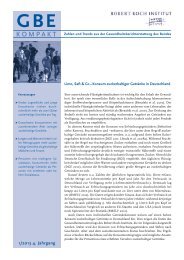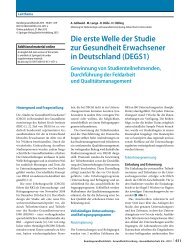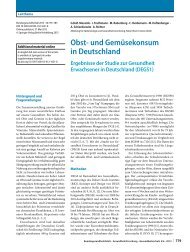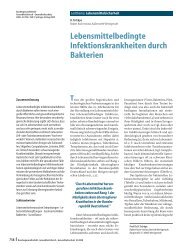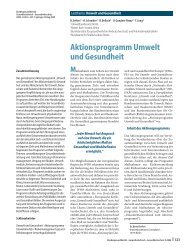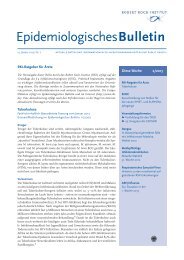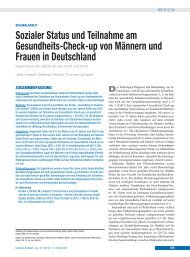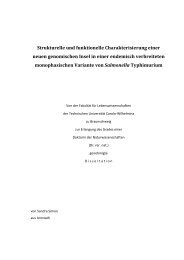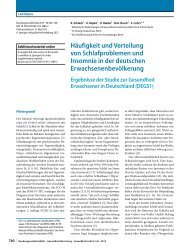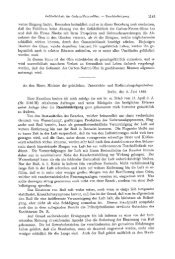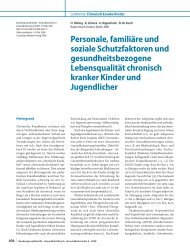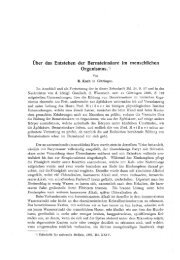HERV-K - RKI
HERV-K - RKI
HERV-K - RKI
You also want an ePaper? Increase the reach of your titles
YUMPU automatically turns print PDFs into web optimized ePapers that Google loves.
Properties of the Transmembrane Protein of <strong>HERV</strong>-K<br />
Figure 4. Influence of the <strong>HERV</strong>-K TM protein on the cytokine<br />
release by donor PBMCs. a, Dose-dependent induction of Il-10<br />
release in PBMCs from two donors by the TM protein of <strong>HERV</strong>-K (0–<br />
medium control) compared to control protein BSA as measured by<br />
ELISAs (mean6SD; n = 3). b, Cytokine array measuring simultaneous<br />
release of cytokines from human donor PBMCs incubated with the TM<br />
protein of <strong>HERV</strong>-K, or control protein BSA, or medium alone after 24 hrs<br />
incubation. The up-regulated cytokines are circled. A list of all analysed<br />
cytokines and their full names are given in Table S1.<br />
doi:10.1371/journal.pone.0070399.g004<br />
More than 300 genes were found up-regulated and more than<br />
300 genes were found down-regulated upon the incubation with<br />
the TM protein of <strong>HERV</strong>-K and the isu peptide of HIV-1. Ten<br />
genes of each group (up or down) with the highest fold change<br />
after incubation with the TM protein of <strong>HERV</strong>-K are shown in<br />
Figure 6. Fifty genes including the first ten genes with the highest<br />
change in expression are shown in Tables S3 (up) and S4 (down).<br />
The expression of the genes up- and down-regulated by the isu<br />
peptide of HIV-1 [28] are also shown for comparison in the Tables<br />
S3 (up) and S4 (down). Nearly the same genes were up- or downregulated,<br />
however with slight differences. For example, in the case<br />
of the isu peptide homopolymer of HIV-1 IL-6 has the first<br />
position in the list of the most up-regulated and MMP-1 (matrix<br />
metalloproteinase 1) the second, whereas in the case of the TM<br />
protein of <strong>HERV</strong>-K MMP-1 has the first position and IL-6 the<br />
second.<br />
As mentioned above, the highest up-regulation induced by the<br />
TM protein of <strong>HERV</strong>-K was shown for the gene of MMP-1<br />
(Figure 6, position 1). MMP-1 is a zinc-dependent protease<br />
essential for the breakdown of the extracellular matrix expressed<br />
on monocytes and macrophages [29]. The second highest upregulation<br />
was that of the IL-6 gene (Figure 6, position 2),<br />
confirming the results on the protein level as shown by the<br />
cytokine array (Figure 4b). Interestingly, the genes with higher<br />
expression are predominantly involved in two processes ‘‘Immunity<br />
and defense’’ and ‘‘Signal transduction’’. Another upregulated<br />
gene was TREM-1 (triggering receptor expressed on<br />
myeloid cells 1) (Figure 6, position 6). TREM-1 has a role as a<br />
regulator of innate and adaptive immunity [30,31].<br />
Figure 5. Influence of the homopolymer of the isu peptide of<br />
<strong>HERV</strong>-K on the IL-10 release by donor PBMCs. a, Comparison of<br />
the isu peptide homopolymer (grey) with a randomised peptide (dark<br />
grey). b, Comparison of the IL-10 release from PBMCs of six donors<br />
treated with one batch and the same amount of the isu peptide<br />
homopolymer, the IL-10 release of their PBMCs incubated with medium<br />
alone was zero.<br />
doi:10.1371/journal.pone.0070399.g005<br />
Among the down-regulated genes were SEPP1 (selenoprotein P<br />
plasma 1, position 1 in Figure 6), FCN1 (ficolin, position 2 in<br />
Figure 6), as well as FCN2 and TREM2 (position 4 and 6 in<br />
Figure 6). These molecules play an important role in innate<br />
immune responses [32–34].<br />
These results indicate that the recombinant TM protein of<br />
<strong>HERV</strong>-K produced in yeasts modulated the expression of<br />
numerous genes in human PBMCs and that this modulation is<br />
similar to that induced by the isu domain of the TM protein of<br />
HIV-1.<br />
<strong>HERV</strong>-K Particles Released from Human Teratocarcinoma<br />
Cells Modulated Cytokine Release<br />
Human GH germ cells express the TM protein of <strong>HERV</strong>-K on<br />
the cell surface and release pleomorphic non-infectious virus<br />
particles [4,7]. The particles were pelleted and purified by sucrose<br />
cushion centrifugation. By Western blot analysis the presence of<br />
the TM protein in the virus preparation was shown (Figure 7).<br />
Incubation of 3610 5 human PBMCs with virus particles<br />
containing approximately 10 ng TM protein (for calculation see<br />
Materials and Methods) induced the release of 80 pg IL-10/ml<br />
(Figure 7). Thus the activity of the virus particles is much stronger<br />
than that of the recombinant TM protein produced in yeast cells<br />
and that of peptide polymers. In parallel virus particles of the<br />
porcine endogenous retrovirus (PERV) were pelleted and assayed.<br />
Although approximately the same amount of PERV was added as<br />
calculated by similar amounts of their Gag capsid proteins, the<br />
induction of IL-10 was lower when compared with that induced by<br />
<strong>HERV</strong>-K (Figure 7).<br />
Discussion<br />
Most retroviruses exert an immunosuppressive effect when a<br />
certain virus load was reached in the infected host. Inactivated<br />
PLOS ONE | www.plosone.org 4 August 2013 | Volume 8 | Issue 8 | e70399



